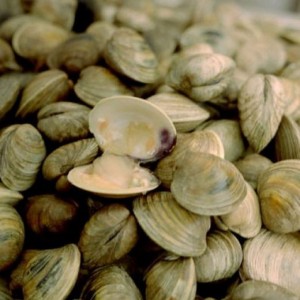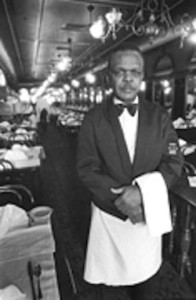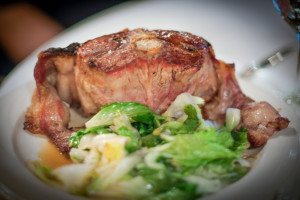In the New York of yesteryear, being a waiter was a profession not just the way-station for actors, models, etc. that it has become. It was a job with which you could raise a family, buy a modest house and lead a life of some dignity. These lifers of the restaurant industry teemed in both ethnic enclaves — Swarthy, smiling Sicilians in Little Italy, surly Jews (“Is the chopped liver good?” “Too good for you”) in the Lower East Side — and some of the older bastions of “Yankee” cooking that were almost exclusively staffed by very dignified, efficient, slightly austere African-American waiters (SJ presumes that this development must have occurred during the “Great Migration” as millions of African American families moved North bringing with them the vastly influential “Low Country” culinary and dining traditions). The late, lamented Gage & Tollner’s in downtown Brooklyn had veteran waiters who had served the old, aristocratic Brooklyn Heights families for decades. The waiters had gold stripes on the sleeves of their jackets denoting their years of service. Lundy’s, on Brooklyn’s Sheepshead Bay, also had dignified African-Americans providing service. Hamburg Heaven, adjacent to Saks Fifth Avenuue, was a favorite of fashionable women. All of the personnel were African-American and casually pleasant. When HG lived in Montclair, NJ., HG often dined at the Wedgewood Cafeteria (closed for many years). It was, even in the 1970s an old-fashioned and gracious establishment much favored by blue-haired ladies and other mature folk. There were many dishes like chicken a la king which did not make demands on people masticating with dentures. The Wedgewood had a unique feature which set it apart from the rough and ready cafeterias like the Belmont, Dubrow’s and others HG frequented in Manhattan: After you ordered your food at the counter, your tray was delivered to your table by a member of the elderly and endearing African American staff who seemed to personally know and care for their aged customers. This made a Wedgewood Cafeteria meal quite an elegant experience.
The African American Waiters Of Old New York
July 13th, 2015 § 2 comments § permalink
Mutton Chops
February 24th, 2015 § 0 comments § permalink
If you are a happy carnivore with a taste for robust red meat, there is nothing better than a big, rare mutton chop. Oddly, it is not a celebrated menu item in New York or Paris. (If you search, you can find mutton chops in London). In times past you could find mutton chops at two locations in New York: Keens Chophouse on W. 30th Street and at Gage & Tollner on Downtown Brooklyn’s Fulton Street. Gage & Tollner was founded in 1878 (closed in the 1990’s) and had a mellow antique interior with 38 gas lamps, wood paneling and mahogany tables. The mutton chop was medium in size and served with corn fritters sweetened with a bit of maple syrup. (The combination seemed unusual but it worked). Thankfully, Keens is still in business and their legendary mutton chop is still giant. Prices however are a different story: In keeping with present day oligarchy-influenced New York the chop now fetches $51.00. HG/BSK enjoyed Keens often when they lived on the Upper West Side during the 1960’s.(Prices were much more modest then). Once, during a Boston-type blizzard, HG/BSK ventured out at night, found an intrepid cab, and supped on Keens’ mutton chop, skillet sized golden hash browns and wine. Only two tables in the restaurant were occupied. Keens (founded in 1885) was not only a cold weather choice. On a blazing July day, HG/BSK shopped for baby furniture at Macy’s (baby daughter Lesley was due in August). HG and very pregnant BSK left summer heat behind and had an early dinner of roast beef, fiery horseradish and Yorkshire Pudding at Keens. The beautifully aged restaurant interior was cooled by very modern air conditioners. HG/BSK felt they were dining in late autumn London. Keens now charges $58.00 for its prime rib.
HG’s Delicious Lunch: Corn Fritters and Chicken Salad
September 1st, 2013 § 0 comments § permalink
After contributing nothing, except appreciation, to the sterling culinary efforts of HG/BSK’s talented family, HG finally cooked something. Very blustery day on Prince Edward Island. An abundance of cooked corn and cold chicken in the refrigerator. Corn fritters and maple syrup preceded by chicken salad seemed like a good idea for a lunch while watching the roiling surf. Here’s how HG made the crispy little, corn-filled fritter yummies: One cup of buckwheat pancake flour plus a beaten egg plus a cup of milk and a tablespoon of canola oil. A dash of baking powder. Mixed it all up. Scraped the kernels off five ears of cooked corn. Some more mixing. Fried spoonfuls in sizzling canola oil. Good stuff. On to the the Chicken Salad: First, HG added plenty of sliced scallions to the cut up chicken. (HG and BSK have a tendency to add scallions to almost everything but ice cream). In a bowl HG placed a healthy amount of Hellman’s Mayonnaise (one of the few good supermarket perennials). Added a robust amount of curry powder (feel free to add a bit of cayenne if your curry powder is too mild). Mixed the chicken/scallions with the curry/mayonnaise. Plated it with a spoonful of mango chutney (and some peanuts for crunch.) (Unlike HG’s beloved BSK, HG does not fancy chicken salad. The exception is when HG prepares it.)
HG often accompanies the Asian-flavored salad with papadums, the crisp Indian flatbread.The corn fritters brought back memories of the long-shuttered, wonderful Gage and Tollner Restaurant in downtown Brooklyn. G and T served a thick and juicy mutton chop with corn fritters and the combination worked beautifully. There was a dish on the G and T menu that HG never encountered elsewhere: Sauteed clam bellies. The rubbery tails were snipped off the tender bellies. The bellies got a light dusting in seasoned flour. A swift saute in bubbling butter. A squirt of lemon juice and a dash of hot sauce. Lovely appetizer. HG’s going to make an effort to duplicate this dish and will report success or failure.
No to Nostalgia
July 12th, 2013 § 2 comments § permalink
HG/BSK watched a World War Two propaganda movie (set in an improbable Poland) with perky Ida Lupino and stiff Paul Henreid. Excruciating. Terrible acting. Moronic plot. Next night watched Detective Story, the film adaptation of Sidney Kingsley’s Broadway hit play of the same name. When it was released the film was lauded for its realism. Hmmm…Kirk Douglas and Eleanor Parker are the stars and the deliver stagey, scenery-chewing performances. William Bendix, in a supporting role, is the only actor in the film who seems to have a grasp on naturalist performing. HG/BSK agreed: Today’s movie actors are infinitely better than yesterday’s. Yes, there were interesting personalities in the past (Cagney, Bogart, Gable, etc.) but few actors with the abilities of today’s stars. No one with the range of Meryl Streep, Philip Seymour Hoffman and many others. Now, how does this relate to HG’s main focus, food? Well, HG may get nostalgic, and rightfully so, about long closed classic New York restaurants like Gage & Tollner, Luchow’s and Christ Cella; also, HG may get a bit wistful recalling the hearty blue collar eats of a New York that simply does not exist anymore. But, the reality is that today’s restaurant cooking is much better than that of the past. There is more emphasis on fresh, local ingredients and less use of butter, cream and heavy sauces. Greater use of a wide range of international ingredients. HG/BSK thought about this while enjoying imaginative dishes at 3 Petit Bouchons, a charming Montreal bistro. Grilled octopus with grilled potatoes. Cod with fiddlehead ferns and asparagus. Duck confit on Waldorf salad. Unusual sauces. A light touch. Dishes that would never have appeared on a menu 40 years ago. Also, because of changes in immigration patterns and disruptions in Asia and the Middle East, today’s restaurant diner (especially in New York) can taste extraordinary (and often very inexpensive) dishes from many parts of China as well as Thailand, Burma, Malaysia, India, etc. And, excellent Syrian, Lebanese, Turkish food abounds. The exposure to these diverse cuisines and the availability of the ingredients to prepare them has been one of the great boons to our restaurant culture — expanding palates and influencing chefs in the most positive way. To give you an idea of how insular cuisine was (even in New York) the big town in the 1950’s had only one Mexican restaurant — Xochitl. And, that was quite ordinary and Americanized.
Comfort Defined
January 30th, 2013 § 0 comments § permalink
“Comfort” in terms of restaurants is hard to define. There are plenty of neighborhood diners and the like serving up comfort food from meatloaf to frito pie, but for HG, a “comfort” restaurant has to have longevity (restaurant has been around a long time); old fashioned decor; professional waitpersons with long years of service; an unchanging menu. “Comfort” means a democratic approach. No special deference to big shots. No “Siberia.” Gage & Tollner (long closed) in Brooklyn met HG’s “comfort” criteria. So did the two (now closed) “dairy” restaurants on the Lower East Side — Ratner’s and Rappoport’s. As far as places that are still in existence, HG has three favorites. In Boston, it’s Durgin-Park. Very touristy and very plain spoken. HG likes to start with clams on the half shell. Then, a giant slab of rare roast beef (or chicken pot pie or grilled knockwurst with Boston baked beans). For dessert, New England Indian Pudding, natch. In Chicago, nothing beats Gene & Georgetti for old time Windy City flavor. Sirloin steak with a “Garbage” salad and fried onion rings. In San Francisco, Tadich Grill does the best Pacific seafood. HG has one or two Sloe Gin Fizzes at the bar. When seated at table, HG dives into a Dungeness crab cocktail, sauteed Petrale sole or the vast Cioppino, the incomparable seafood stew. A true New York “comfort” restaurant is Keen’s Chop House, home of the famed (giant) mutton chop. However, the prices at Keen’s continue to move upward so the eatery is barely in the “comfort” zone and has instead moved into masochist territory. With the guidance of SJ, HG is comforted at affordable Chinese restaurants in Manhattan, Flushing and the Sunset Park neighborhood of Brooklyn.
But wait…There’s a fourth. And, it truly defines the word “comfort.” Located in Italy, of course. HG refers to Bologna’s wondrous Ristorante Diana. A very old restaurant with a beautiful mirrored interior. Gentle lighting. Helpful (never obsequious) service. HG starts his meals there with a glass of Prosecco while contemplating the delights which will ensue. A bottle of Emilia Romagna’s red Sangiovese is uncorked. Then, a plate of tagliatelle dressed simply with butter and the best Parmigiano Reggiano. Using an instrument designed for the purpose, the waiter showers the pasta with shavings of white truffle. The heady fragrance fills the air and occupants of neighboring tables nod in approval. This is followed (and it is not an anti-climax) by Bollito Misto. For those unfamiliar, this refers to a variety of boiled and poached meats. At Diana, the Bollito Misto is served from a large trolley wheeled by a very large man. On the trolley are two poached sausages, Cotechino and Zampone, plus boiled beef, pork and tongue — all juicy and flavorful. This is accompanied by salsa verde and a pungent mostarda di frutta. Dessert is Semifreddo followed by a number of snifters of grappa (for digestive purposes). A brief stroll and a long nap is obligatory. True Comfort.
Lamb
November 18th, 2012 § 0 comments § permalink
When HG was a very, very little boy lamb chops were his favorite dish. The little guy called them “ompalomps.” HG hated spinach. So, his cunning Mom buried the spinach in buttery mashed potatoes and HG consumed every drop. Okay, enough sickeningly cute kiddy memories. Lamb chops remain an HG favorite. Best lamp chops ever were the chops at Leon Lianides’ great Greenwich Village restaurant, the Coach House. The rack of lamb was also wonderful there, only matched by the rack at Le Stella, the Paris brasserie. But the marvel, the ultimate not-to-be-equalled rack is found at an unlikely place: The Grand Hotel Restaurant in Big Timber, Montana. HG discovered it because Big Timber is midway, between Denver and Vancouver, so it was a logical place to stop when motoring between the two cities. At the Grand Hotel you accompanied the lamb with a robust red wine from Walla Walla, Washington (HG thinks Wall Walla has the best red in the universe). Another favorite of lamb lovers is the mutton chop at New York’s venerable Keen’s Chop House. You can get it with Yorkshire Pudding and it is a treat. (The old Gage & Tollner’s in Brooklyn served their mutton chop with corn fitters, a nice idea). BSK likes to butterfly a leg of lamb, marinate it in red wine, garlic and herbs and then barbecue it to crusty perfection. Serves it with Greek Avoglemono sauce (eggs and lemon juice are the principal ingredients). Big time gourmandizing.
Much Missed Shad
April 14th, 2012 § 4 comments § permalink
One of the joys of a New York City spring was a great dish that appeared in a few restaurants at that time of year. HG refers to shad and shad roe. HG enjoyed it at two (long departed) New York restaurants — Christ Cella on E. 44th in Manhattan and the beautiful, venerable Gage & Tollner in downtown Brooklyn. Gage & Tollner was one of a kind — the oldest restaurant in Brooklyn and a mellow paradise of mahogany, tile floors and working gaslights. The restaurant was very much the favorite of the aristocratic old families who inhabited the gracious brownstones of Brooklyn Heights. Waiters were courtly, dignified African-Americans (many had been at G & T for decades and had service stripes on their jacket sleeves to prove it). G & T served a big platter of broiled shad and sauteed shad roe drenched in lemon butter and accompanied by parsleyed new potatoes, a rasher of crisp bacon and cole slaw. HG’s beverage of choice while relishing this dish was ice cold Ballantine’s India Pale Ale.
World headquarters of shad and shad roe was the town of Edgewater on the New Jersey banks of the Hudson River just north of the George Washington Bridge. Edgewater was the home of rivermen who netted shad in the Hudson for generations (for more information on the Hudson River Shad runs, refer to Joseph Mitchell’s wonderful essay The Rivermen collected in his book Up In The Old Hotel). HG once arranged a memorable shad and shad roe feast for journalists in Edgewater. The rivermen built a giant fire of wood and charcoal. Shad filets were nailed to oiled maple flanks and these were propped around the blaze. They were cooked to an astounding degree of succulence. Meanwhile, over charcoal barbecues the roe and bacon sizzled in big cast iron pans. This was a job for the women of Edgewater and these admirable ladies also provided extraordinary potato salad and cole slaw. Yes, it was a feast for the ages. Doubt whether it could be repeated today.
Gone But Not Forgotten Restaurants: 4 Seafood Greats
June 27th, 2011 § 3 comments § permalink
While New York is still chock full of great seafood restaurant there are four (now shuttered) that HG still pines for.
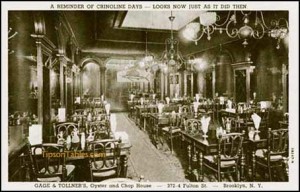 1. Gage and Tollner in downtown Brooklyn. One of the oldest restaurants in New York City, this was a hangout for aristocratic old families of Brooklyn Heights. Entirely illuminated by gas lighting, the untouched turn of the century decor was just wonderful. Dignified, African-American waiters. The sleeves of their jackets had stripes denoting years of service. Average was 25 years. Best dishes: Sauteed clam bellies. Shad and shad roe (in season). Clams and oysters on the half shell. There was also a meat dish fancied by HG: A big, rare (Juicy and gamy) mutton chop accompanied by corn fritters.
1. Gage and Tollner in downtown Brooklyn. One of the oldest restaurants in New York City, this was a hangout for aristocratic old families of Brooklyn Heights. Entirely illuminated by gas lighting, the untouched turn of the century decor was just wonderful. Dignified, African-American waiters. The sleeves of their jackets had stripes denoting years of service. Average was 25 years. Best dishes: Sauteed clam bellies. Shad and shad roe (in season). Clams and oysters on the half shell. There was also a meat dish fancied by HG: A big, rare (Juicy and gamy) mutton chop accompanied by corn fritters.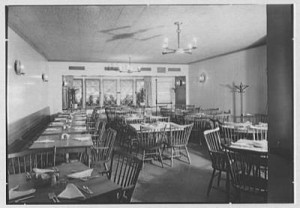
2. Gloucester House in the East 50’s. Chaste New England decor. Very expensive. Clientele: Rich Park Avenue types and publishing biggies. HG often saw Helen Gurley Brown (One time Editor of Cosmopolitan Magazine, author of Sex and the Single Girl and longtime advocate of sexual liberation) and her film producer husband David Brown (“Jaws”, “The Sting.” etc.). Best Dishes: Broiled lobster. Lobster Newburg. Potatoes au gratin. Fried onion rings. Swordfish.
3. Seafood of the Aegean in the East 50’s. Decor: Stylish, yet Greek (hard to imagine, well…just try!). Clientele: Madison Avenue advertising executives. Best dishes: a lemony Avoglemono soup. Shrimp Santorini — Jumbo shrimp with grilled whole tomatoes, tomato sauce and sharp feta cheese — served bubbling hot.
4. Sweets located on the East River waterfront near Wall Street. Decor: Very austere, no frills. Crusty, bad tempered old waiters. Clientele: Wall Streeters and the coffee, tea and cocoa importers that were HQ’d on Water Street. Best dishes: The very best and freshest simply broiled and sauteed fish; clams, oysters, lobsters and crabs—all purchased that morning from the nearby Fulton Street Fish Market.
Happy As A…….
May 30th, 2011 § 1 comment § permalink
Clam. HG does love that briny bivalve. The love affair began decades ago at the Harbor Rest fast food and sea food joint on Jamaica Bay in New York’s Rockaway Park — at the time, the proletarian Hamptons. HG, 13-years-old, was employed as an oyster and clam shucker (also a peeler and de-veiner of shrimp). HG ate a lot of clams. His mantra: One for the boss and one for me. HG’s oyster passion developed later. Boyish passions subside but not HG’s clam lust. HG ate scores at Lundy’s located at Brooklyn’s Sheepshead Bay. He downed them at Nathan’s in Coney Island; at Manhattan’s Grand Central Oyster Bar. HG refers to raw clams (cherrystones and little necks ) on the half shell. HG has always fancied clams (and oysters) unadorned. Maybe a modest squeeze of lemon. No beverage but beer. Lundy’s served its raw clams with hot, buttered, straight-from-the oven biscuits — HG never complained.
When HG lived in Colorado HG began his daily lunch at the Palm Restaurant with six little necks (some 1,500 miles from the Atlantic but surprisingly sweet and fresh…go figure). HG has never neglected cooked clams, preferably as part of Italian cuisine….clams posillipo (clam broth enriched with tomatoes); Linguini with white clam sauce; clams casino (light on the bread crumbs, heavy on the garlic, bacon strip optional). HG is not a big clam chowder fan. HG finds New England style overpowers clams and Manhattan style is simply inedible. The best is light clam chowder served at the Legal Seafood chain in New England (an excellent purveyor of clams and oysters).
A great clam dish was sauteed clam bellies at the late, great Gage & Tollner’s in Brooklyn. HG is a fan of the fried soft shell clams available a scores of New England shacks. When resident at the family beach home on Prince Edward Island, HG downs scores of steamers, cleansed in broth and dipped in Tabasco-enhanced melted butter.
As stated in a previous post, the true clam heaven was Fire Island, the magical barrier beach that stretches for miles off Long Island between Great South Bay and the Atlantic Ocean. After a day of Fire Island beach and sea fun, the HG family and friends would arm themselves with buckets and wade into the Bay. It was a clam bonanza. Following would be raw clams, clams casino and BSK’s extraordinary white clam sauce adorning bowls of linguini fini. The HG and BSK dune house overlooked the Bay and Ocean. Sunsets. Infinite whitecaps. Many martinis. Much beer and cheap, cold white wine. A jolly, sunburned time. Happy memories.